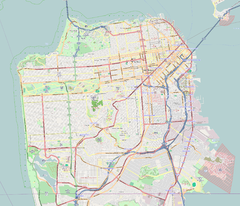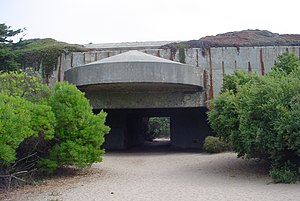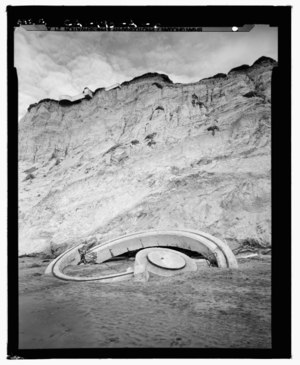I had two horses boarded at Palo-Mar Stables in Daly City back in the earlier part of the 1990s and Fort Funston gave liberty to dog walkers off-leash and killed all of our beach rides with out of control dogs that attacked both of my horses leaving frightened, spooky runaways. No matter the berth that I gave to those dogs, meaning I would ride deep into the ocean those dogs would barrel in after us and bite at us. This was so horrid I ended up having to move to Park Pacifica in Pacifica, some 30 to 40 minutes farther than Palo-Mar. The added gas and forced drive made for sound horses however the fact that dogs off-leash were not allowed made for some frustration over the years.
Just returning home and unable to live in the Richmond due to my mothers untimely death in January of 2017 I moved to the Parkmerced neighborhood. As this is 2018 and my niece wanted to go to Fort Funston to enjoy an outing with her dogs and my new service dog I reluctantly said yes, Fort Funston should be closed.
This is a simple post to the irresponsible dog owners whether dog walkers or owners, I was screamed at for not having my dog off-leash, I was attacked. As my niece and I ventured down the beach and I had explained to as many people as possible that this dog was a service dog and that he had just recently been rescued from the Pound I paid attention and gave wide berths to all dogs and people, from no where the following has stunned me still today and made my service dog change. He had been looking and enjoying the company of the many dogs and bam out of no place a dog hit us near the curb of the oceans very small waves, far from the cliffs I fell to the open water. The owner in madness came and jumped on her dog nailing my dog yet again, the rolling about was of an impact that stills my sight even now as I have never seen any person man or woman tumble into a dog pile that gave horror a new name. I only could see my service dog slightly as the woman had pinned him down with her dog. As my service dog laid pinned to the ground he looked in action and I said to the woman "get off", as the woman did not respond the rolling about of her attempting to grab her dog as she still had my service dog pinned went on for more time that I am am able to acknowledge as I was helpless. My dog was hit so hard, I had been bolted sideways and subsequently knocked about as if I had fallen from a horse, the impact from that hit is still being felt today as both my service dog and I are still limping about. Upon the final moment of that woman grabbing her dog my dog was loosed and turned to the open ocean for protection, I could not walk and stumbling my hand felt bad, I did not want to look until the shock wore off. The fact that the woman and her dog disappeared on the beach was wretched, defining there would be no healing from that heated attack of dog, the teeth from the dog that was off leash did not break my skin leaving only a deep bruise on my knuckles with his fangs, however that dog did nail my service dog, treated with betadine as provided by my niece immediately, his obvious wounds fell no illness in the end however the initial impact has left my dog injured in his shoulder and elbow and he hobbles still today. Whether or not my service dog had a pre-existing condition will not be known as he was sound when I got him, he has been treated with rest and is progressing however I still see that he is lame and that is frustrating to the memory of the earlier part of the 1990s. My horses on different occasions narrowly escaped and thus the picture will suffice for impact to state of whom does not understand the narrowly escaped injuries that would have ended in having to have my horse put down.
As this is to the fact that this is second time that I have been attacked by dogs at that particular beach and horridly the view was exactly the same. Dog owners, Dog Walkers you are violating the San Francisco leash law and as a result have caused my service dog injury and to bark at every dog he sees to be a threat, shame on you.
Subsequently the goating at Dog Runs is wretched, my service dog got it yet again by another dog that the owner and or dog walker allowed to go right up to the fencing and allowed her dog to run its bite all along the bottom attacking him solidly through the rails of the dog run for some 10 feet and then, the dog owner or Dog Walker just walked off ever so quickly. The poor behavior of dog owners and Dog Walkers in this City should be re-examined and to point the small dogs have become vicious behaving aggressively. Although their attack is overlooked as cute.
Shame on all of you as now my service dog must be kept separate and that is just not fair. In-addition, a dog must bark for ten consecutive minutes to gain attention of the authorities. In my case the 'being goated' is taken into consideration as that is illegal.
- Bank swallow (Riparia riparia)
- The Coastal Trail is temporarily closed due to erosion.
- Fort Funston at FortWiki.com
- Berhow, p. 217
- Fort Funston at American Forts Network
- Wurm, Ted (1979). "S.P. Ocean View Line". The Western Railroader. Francis A. Guido. 42 (468): 6&7.
- Berhow, p. 227
- Richmond P. Davis biography at NCpedia.org
- Gaines, William C., Coast Artillery Organizational History, 1917-1950, Coast Defense Journal, vol. 23, issue 2, pp. 12-13
- Information on black sand at USGS.gov
- "Fort Funston". Golden Gate National Parks Conservancy. Retrieved 2018-04-05.
- "World record toss". Fort Bragg Advocate-News. August 7, 2003; "First Quarter Mile Throw in History at Fort Funston". Business Wire. Business Wire. 2003-07-16. Retrieved May 28, 2009.
- Berhow, Mark A., Ed. (2015). American Seacoast Defenses, A Reference Guide, Third Edition. CDSG Press. ISBN 978-0-9748167-3-9.
- Daerr, Elizabeth G. "Golden Gate NRA Officials Caught In a Dog Fight". National Parks 74 (7-8): 14-15.
- Kent, Matthew W. "4. Fort Funston". Harbor Defenses of San Francisco: A Field Guide 1890 to 1950. 2009. Self-published. ISBN 978-1-61584-163-9.
- Konigsmark, Ted. "Trip 5. Fort Funston". Geologic Trips: San Francisco and the Bay Area. 3rd ed. GeoPress, 2006 [1998]. ISBN 0-9661316-4-9. pp. 98–111.
- Lewis, Emanuel Raymond (1979). Seacoast Fortifications of the United States. Annapolis: Leeward Publications. ISBN 978-0-929521-11-4.
Fort Funston
Jump to navigation
Jump to search
| Fort Funston | |
|---|---|

A hang glider launches from Fort Funston Overlook, San Francisco. The launch platform is modified from a former fire control bunker.
| |
|
Location in San Francisco
| |
| Location | San Francisco, California, United States |
| Coordinates | 37°42′54″N 122°30′07″WCoordinates: 37°42′54″N 122°30′07″W |
| Operated by | Golden Gate National Parks Conservancy |
| Website | Official website |
| Fort Funston | |
| Lake Merced Military Reservation | |
| Near San Francisco, California in United States | |
| Type | Harbor defense installation |
| Site information | |
| Owner | United States Army |
| Controlled by | United States Army Coast Artillery Corps |
| Site history | |
| Built | 1900 |
| Fate | Decommission 1963 |
Recent photo of an emplacement of Battery Davis. Some of the earth covering the fort has eroded.
A 16-inch gun on the road to the fort
Assembling a 16-inch gun carriage at the fort
Panama mount fallen from cliff due to erosion. Another mount can be seen at the top of the cliff.
The Fort was constructed upon windswept headlands along the Pacific coast and Ocean Beach below, above steep sandstone cliffs that provide a nesting habitat for a colony of bank swallows (Riparia riparia). The last remnants of a sand dune ecosystem that once covered the western half of San Francisco grows along the top of the headlands, with trailheads forming part of the California Coastal Trail that runs through San Francisco County.[1]
History
The land was acquired by the federal government in 1900 as the Lake Merced Military Reservation, originally intended to accommodate two 12-inch coast defense mortar batteries in the Coast Defenses of San Francisco (later Harbor Defenses). However, nothing significant was built there until after the American entry into World War I in early 1917. The fort, renamed for Major General Frederick Funston shortly after his death in 1917, began to take shape during World War I, with the construction of a parade ground, barracks and a series of coastal batteries. These were Battery Howe with four 12-inch mortars and Battery Bruff with two 5-inch M1900 guns on pedestal mounts. These weapons were relocated from Batteries McKinnon and Sherwood at Fort Winfield Scott, adjacent to the Presidio.[2][3] Battery Howe was named for Walter Howe, a general and veteran of the Indian wars who died in 1915. Battery Bruff was named after Lawrence Bruff, an Ordnance Corps colonel and instructor at West Point who died in 1911. In 1920 Battery Bruff was disarmed due to a withdrawal from Army service of the 5-inch gun.[2] In the early 1920s, Anti-aircraft Battery No. 5 of three 3-inch guns was built at the fort.[4]Following World War I, the Washington Naval Treaty of 1923 caused the cancellation of numerous battleships and battlecruisers building and planned for the US Navy. Some of the guns intended for these ships were made available to the United States Army Coast Artillery Corps to defend key ports against a potential naval attack. However, only a few of these weapons were emplaced prior to the outbreak of World War II in September 1939. In 1936-1939 Battery Davis was built at Fort Funston, housing two 16-inch Mark 2 Navy guns.[3] These 143-ton guns were moved on railroad cars in 1937 from Mare Island Naval Shipyard to Southern Pacific's Ocean View Station.[5] This was the prototype US 16-inch battery for casemating against air attack, which was adopted for almost all US 16-inch batteries built during the war and retrofitted to most pre-war batteries of this type. It was also the prototype for the Army's M2 carriage; previous ex-Navy 16-inch guns had used a modified M1919 carriage designed for the 16-inch gun M1919.[6] Battery Davis was named for Major General Richmond P. Davis, a Coast Artillery officer who served in France in World War I, retired in 1929 and died in 1937.[7] Also, an unnamed battery of four 155 mm guns on concrete "Panama mounts" was built at the fort circa 1938.
In 1940 Battery Davis was joined by Battery Townsley at Fort Cronkhite. A third 16-inch battery, Battery 129 (also called "Construction 129") at Fort Barry, was built for the San Francisco area during World War II but not completed or armed.[3] Four additional 155 mm guns on Panama mounts were emplaced as Battery Bluff. Also, four 40 mm Bofors gun batteries were placed around the fort.[4]
From December 1941 through April 1944 Fort Funston's garrison included elements of the 18th Coast Artillery Regiment.[8]
The gun batteries were declared obsolete shortly after World War II, but a 90 mm anti-aircraft gun battery was on the site 1953-57 during the Cold War.[4] Fort Funston later became a Nike missile launch site, hosting sites SF-59L (now the parking lot) and SF-61 from 1956 to 1963.[4] The fort was inactivated in 1963 and eventually transferred to the National Park Service to be administered as part of the Golden Gate National Recreation Area. At some point Batteries Howe and Bruff were demolished, while the Panama mounts have either been destroyed by erosion or buried.[3]
Features
The area is covered with a network of trails suitable for hiking or horseback riding. There are two Dutch sand ladders that extend down the dunes to the beach. The beach is known for its magnetic sand[9] and strong currents, discouraging swimming. Fort Funston is a popular dog park and the only park in the GGNRA that allows off-leash dogs. The strong, steady winds make the cliffs overlooking the beach a popular site for hang gliding. The gliding is rated intermediate difficulty (Level III).[10]Additionally, the world record for the farthest thrown object was set here in 2003 by Erin Hemmings, who threw an Aerobie flying ring 1,333 feet.[11]




















No comments:
Post a Comment